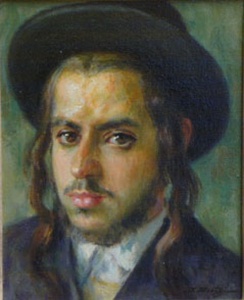Jewish Genre Painting
Itshak Holtz is an artist totally immersed in the Jewish genre. He was born in Poland, grew up in Israel, mainly in the Jerusalem neighborhood of Geula, and for the last thirty-five years he has maintained homes in both New York and Jerusalem. He is comfortably rooted in a Jewish life of religiosity, love of Israel and respect for the Jewish experience in the Diaspora. Holtz is a thoroughly modern Jew; a cosmopolitan with deep roots in Israel and America, who is also a highly successful painter specializing in one aspect of his own history and reality, Jewish genre painting.
Genre painting arises in the Western artistic tradition in the late Renaissance. In Northern Europe scenes of everyday life suited the ascendant burgher class that celebrated the virtues and values of home, hearth and family. Frequently practiced by lesser talents, genre painting was also championed by many of the great seventeenth century Dutch masters such as Holbein, Jan Steen and Vermeer. Soon it caught on in Italy, Spain and England appealing to the growing tourist trade and by the nineteenth century was a major secondary market in most European, English and American painting. It is the consummate form of democratic artistic expression, celebrating the prosaic life of the common man with occasional forays into picturesque poverty and sentimental histories. The first and most proficient Jewish practitioner was Moritz Daniel Oppenheim, especially his wildly popular series of prints, Pictures of Traditional Jewish Family Life published in the 1870’s. This series depicts the eighteenth century Jewish community of his native Hanau, Germany in what was a nostalgic look at a recent but vanished ghetto past. Itshak Holtz has focused on similar material with an important difference. The world he depicts is alive and well in Monsey, Boro Park and, of course, Jerusalem.
![Returning from Shul (2002) Oil on Canvas [19 5/8 x 12] by Itshak Holtz Private Collection Returning from Shul (2002) Oil on Canvas [19 5/8 x 12] by Itshak Holtz Private Collection](https://richardmcbee.com/wp-content/uploads/2001/01/Holtz-returning-from-shul-176x300.jpg)
Unlike some of his earlier paintings that depicted tailors, sofers, fishmongers and pressers, in this world piety replaces the workplace.
![Shamash Learning in Shul (2003) Oil on canvas [21 7/8 x 11 7/8] by Itshak Holtz Private Collection Shamash Learning in Shul (2003) Oil on canvas [21 7/8 x 11 7/8] by Itshak Holtz Private Collection](https://richardmcbee.com/wp-content/uploads/2001/01/holtzshamashlearning-164x300.jpg)
For over forty years Itshak Holtz’s subjects have been the back alleys and markets of Me’ah Shearim, Geula, and other religious neighborhoods in Israel. Street scenes, synagogue interiors and portraits of men learning, praying and simply inhabiting the world of yiddishkeit have been the motifs that fascinate him out of love and respect. Reflecting deep affection for his subjects many of his favorite portraits have been held in his private collection in trust for his children.

Portrait is typical in its directness and honesty. The hasid’s peyos frame his face like the columns at the entrance to the Temple sanctuary. And yet the placement of his eyes, nose and mouth is slightly off center, creating a wonderful tension between the formulaic trappings of piety (black hat, peyos and white shirt) and the complexities of a real person. His extensive training years ago at the Bezalel Art Academy in Jerusalem, the Art Students League in New York especially with Robert Brackman and the National Academy of Design with Robert Philipp still influences him. The ability to combine inventive and detailed compositions with evocations of deeply individual religious feeling stem as much from the artist as from his subjects.
Holtz’s Jewish genre painting represents an essential aspect of contemporary Jewish life. It reveals a world that many secular Jews choose to either ignore or reject. This world is an important link with a vital Jewish past even as it represents a growing Jewish present that must be explored with a finely tuned combination of sympathy and honesty. Genre painting offers a particular sensibility, attention to detail and nuance of place and time that provide a unique opportunity to explore this world. Itshak Holtz masterfully opens the door to begin this exploration.
Published in The Jewish Press